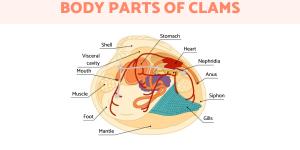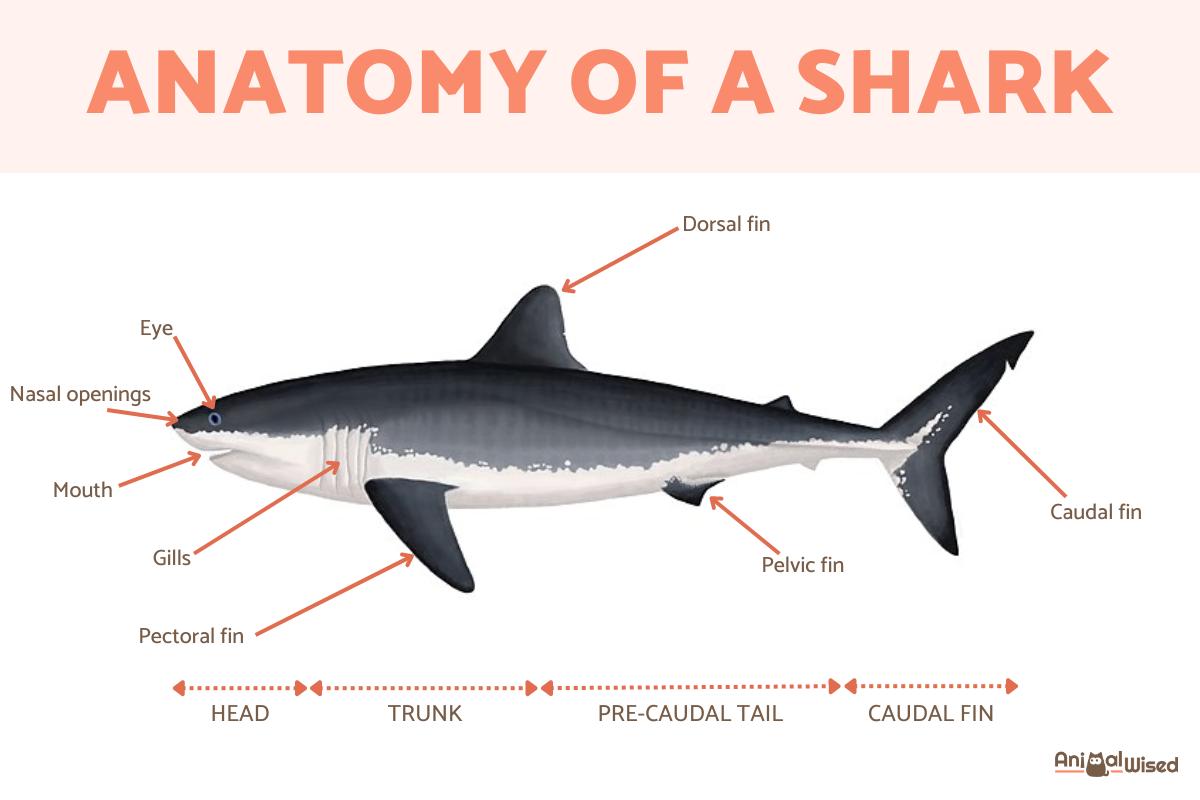Anatomy of a Shark - Shark Body Parts

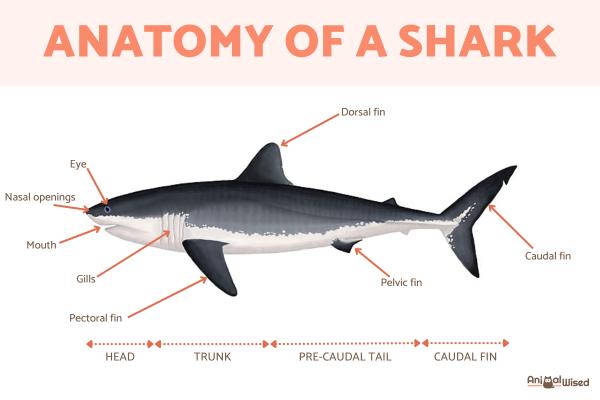
Sharks are cartilaginous fish of the class Chondrichthyes. They are highly evolved aquatic vertebrates that have dominated ocean ecosystems for more than 400 million years, although this does not mean they don't have predators of their own. The anatomy of the shark is adapted to marine ecosystems, something that provides a great example of their evolutionary adaptation. It is such evolutionary advantages that have allowed them to thrive for such a long time. Their imposing appearance and enigmatic behavior have led them to be one of the most fascinating animals, even if studying their appearance and behaviors can be difficult due to their habitat.
We have learned enough to have a good understanding of the anatomy of a shark. AnimalWised discovers how shark body parts play a crucial role in their survival and success as marine predators. We also provide helpful diagrams to have a better visualization of shark anatomy.
Head of a shark
More than the most intimidating part of their anatomy, a shark would not survive without their head. Although their brain is relatively small compared to the rest of their body, their head is wide, triangular and very robust. They can use it to slam against individuals, as well as tearing at prey with their razor sharp teeth. The shape of the shark's head is also very important for speed in the water since it makes them so aerodynamic.
The following are the main parts of a shark's head:
- Nasal openings: most sharks have a series of slits or pits on the front of their snouts, known as nasal openings. These are the equivalent of nostrils that allow them to detect chemicals in the water and track prey.
- Eyes: the eyes are usually large and well developed, giving them excellent vision underwater, even in low light conditions.
- Mouth: the mouth of a shark is large and located at the bottom of the head. It is equipped with several rows of sharp teeth which are replaceable and adapted to the diet of each species. Some have teeth designed to cut, others to tear and some to shred. The constant replacement capacity of teeth allows them to keep them sharp throughout their lives. Learn more about how many teeth sharks have in our related article.
- Spiracles: some shark species have two small openings located behind their eyes known as spiracles, as depicted in the diagram below. They use them to breathe without having the need to constantly swim. Learn more about this ability with our article on whether there are animals that don't sleep.
- Gills: as with all fish, sharks have gills. Theirs are located in openings on the sides of the head, behind the eyes. Gills are essential for breathing as they allow the shark to extract oxygen from the water. Water flows over the gills as the shark swims and the gill blades draw dissolved oxygen from the water and release carbon dioxide.
Sharks have a series of sensory organs in their heads that help them detect their prey and navigate their environment. These include electroreceptor organs called ampullae of Lorenzini, sense organs which are able to detect electrical fields generated by other organisms in the water. They also have a system known as lateral lines that detect changes in water pressure, allowing them to perceive movements and vibrations in their environment.
Lorenzini ampoules
Ampullae of Lorenzini are highly specialized sensory organs found on the heads of sharks and other cartilaginous fish species such as rays and chimeras. These organs play a crucial role in detecting electrical stimuli and locating prey in the water:
- Ampullae of Lorenzini structure: ampullae of Lorenzini are small bulb-shaped structures found primarily on the skin of the shark's head and around the underside of their mouth. Each ampullae is made up of a series of sensory cells called electroreceptors and a series of gel-filled tubes that connect these cells to the surface of the skin.
- Ampullae of Lorenzini function: ampullae of Lorenzini are extremely sensitive to electrical signals produced by other aquatic organisms. Sharks use them to detect electrical fields generated by potential prey, even when they are camouflaged or buried in sand. In addition to locating prey, ampullae of Lorenzini can help sharks detect changes in the water's electric field, indicating the presence of predators or other sharks.
- Scientific research: ampullae of Lorenzini have been the subject of scientific research and have inspired technological advances. This includes electric field detection devices used in marine biology studies and in medical research. Scientists have studied how ampullae of Lorenzini work to better understand shark physiology and behavior.
A piece of a shark's anatomy we have not mentioned is the tongue inside their mouth. Learn more with our explanation of how a shark's tongue works.
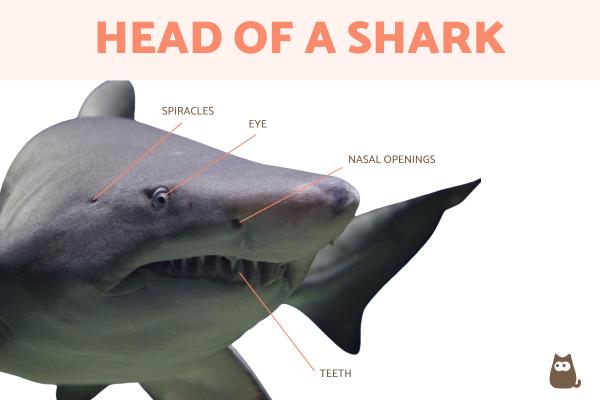
Shark teeth
Shark teeth are one of the most distinctive and fascinating features of these marine creatures. The adaptation of shark teeth to their specific feeding habits is a stunning example of evolution in action. These highly specialized dental structures are essential to the survival of these animals and are one of the reasons they are such successful predators in oceans around the world.
- Types of shark teeth: sharks have several types of teeth in their mouth which vary in arrangement depending on their species and feeding function. Some sharks have conical, pointed teeth which are ideal for catching and holding elusive prey. Other sharks have sharp and serrated teeth designed to cut and tear flesh. Other species have flat teeth and crushing molars that allow them to crush prey with hard shells, such as sea turtles or crustaceans.
- Continuous Replacement: one of the most notable aspects of shark teeth is that they are continually replaced throughout the shark's life. Teeth wear down or break over time due to their feeding and hunting habits. To compensate for this, sharks have multiple rows of teeth in their gums, as seen in the photo below. When a tooth is lost or broken, a new one moves in from the back row of teeth to replace it. This tooth replacement process is constant and allows sharks to keep their teeth sharp at all times.
- Tooth function: a shark's teeth are crucial to their survival and success as marine predators. They allow them to capture, hold, cut or crush prey, depending on their diet. Some species, such as the great white shark (Carcharodon carcharias) have teeth specially designed to tear apart large prey, such as seals or large fish.
Learn more about the diversity of these fish species with our article on the 10 largest sharks in the world.
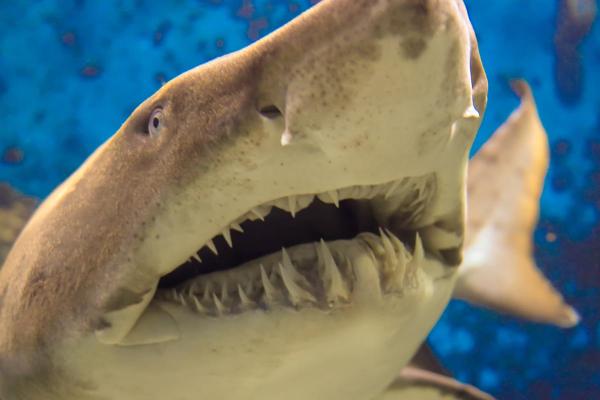
Shark fins
A shark's fins are fundamental anatomical structures that play multiple roles in their marine life. Each type of fin serves a specific function in shark anatomy and swimming behavior. Together, these fins allow sharks to be highly effective and agile predators in their aquatic environment. The following are the different types of shark fins:
- Pectoral fins: the pectoral fins are located on the sides of the head and body, near the gills. They are primarily responsible for the shark's stability and direction while swimming. They allow the shark to make precise turns and maneuvers which is essential for hunting prey and avoiding predators.
- Dorsal fin: the dorsal fin is one of the most iconic features of sharks. It is located on the upper part of the body and is used to maintain stability and direction while the shark swims. It can also help control the tilt of the shark during diving and hunting. It is the fin that can appear sticking out of the water when they swim near the surface, something used to denote a terrible prospect in many movies.
- Caudal fin: otherwise known as the tail fin, this shark fin is located at the back of the shark's body. It is primarily responsible for propulsion through the water, allowing them to chase prey and otherwise move efficiently through the water. The caudal fin shape varies according to species, although it is usually structured to provide optimal speed and power. It can be heterocercal when characterized by having the upper lobe longer than the lower lobe. This creates an asymmetrical shape that provides stability and greater swimming efficiency. This type of caudal fin is typical of primitive sharks, such as sharks of the Hexanchidae family. Homocerca caudal fins are common in many modern sharks. It has lobes of equal length on the top and bottom of the fin, resulting in a crescent shape. This form of caudal fin is efficient for propulsion and speed, being found in fast predators such as the great white shark. There is also the heteropinnate caudal fin, a variant found in some sharks of the Alopiidae family. It is characterized by having an upper lobe significantly longer than the lower lobe. This creates an elongated and forked caudal fin shape. This shape of tail fin allows these sharks to make distinctive striking movements, which they use to stun their prey before the kill.
- Pelvic fins: the pelvic fins are located on the underside of the body, near the pectoral fins. They aid in the shark's stability and balance while swimming. Some species of male sharks use their pelvic fins for sperm transfer during mating.
- Anal fins: not all shark species have anal fins. In those that do, the anal fins are located on the underside of the body, behind the pectoral fins. Their presence or absence can vary depending on the species. They help with stability and depth control during swimming. The shark anatomy diagram below shows a shark which has anal fins.
Learn more about these vital parts of a shark's body with our article on how many fins sharks have.
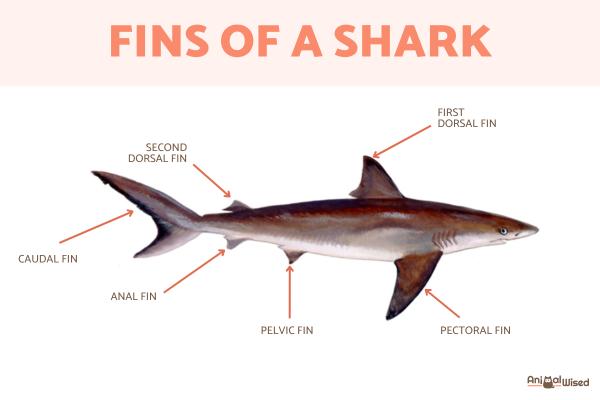
Shark skin
Another part of shark anatomy which is very distinctive is their skin. Skin and dermal denticles are other key adaptations that make sharks highly effective predators in their aquatic environment. They allow them to swim quickly, hunt prey stealthily and withstand the often inhospitable conditions of the marine environment.
Dermal denticles cover the skin of sharks. These are small modified scales that have a structure similar to that of teeth, shaped like small plates or serrated scales. They are unique to sharks and cartilaginous fish which provide them with a number of adaptive advantages. This is because they:
- Help reduce the friction of the water when the shark swims.
- Improve swimming efficiency and reduce water resistance, allowing sharks to swim faster and with less effort.
- Provide a rough skin effect that allows water to flow more smoothly over the shark's body, thereby reducing hydrodynamic noise that could alert prey.
- May have antimicrobial properties, which helps prevent infections of the shark's skin.
Shark skin can vary in color and patterns depending on the species and the environment in which they live. Some species have darker skin on top and lighter skin on the underside. This provides ideal camouflage when hunting from below or being seen from above.
Other sharks, have a distinctive coloration with a gray or blue top and a white underside. Shark skin is not continually renewed like other animals. Instead, sharks shed their denticles in a process called ‘dermal molting’. During this time, sharks lose and replace their denticles to maintain skin health.
shark internal organs
The internal body parts of a shark's anatomy are also important for interacting with their environment, even if less obviously so. Each internal organ plays a role in giving them an adaptive advantage in their environment. Each of the following internal organs of sharks plays a crucial role in their physiology and function:
- Liver: the liver of sharks is a large organ that is essential for several functions. Some of these main functions include storing energy in the form of lipid-rich oils. These provide them with positive buoyancy and detoxifying chemicals.
- Stomach: sharks have a stomach that is divided into two parts, the anterior stomach and the posterior stomach. The anterior stomach is responsible for the initial digestion of food, while the posterior stomach is responsible for more complete digestion.
- Intestine: the intestine of sharks is a long, coiled organ that continues digestion and absorption of nutrients from food. Sharks have an efficient digestive system that allows them to extract nutrients from a variety of prey.
- Pancreas: the pancreas of sharks secretes digestive enzymes that help in the breakdown of food in the intestine and also regulate blood glucose levels.
- Heart: the shark's heart is a muscular organ that pumps blood through its circulatory system. Sharks have a single ventricle and a single atrium, differentiating them from mammals and birds that have four heart chambers.
- Kidneys: a shark's kidneys are responsible for the excretion of waste products and the balance of electrolytes in their body. Marine sharks face unique challenges in maintaining the balance of salt and water in their bodies due to the salinity of the environment in which they live.
- Reproductive organs: sharks have internal reproductive organs. In males, the reproductive organs include the gonads which produce sperm and are the equivalent to mammalian testicles. Female shark gonads produce eggs. Fertilization is internal in all sharks, but some are viviparous and others oviparous, meaning they gestate the young in a uterus or lay external eggs, respectively. Learn more about what are oviparous animals.
- Gallbladder: the gallbladder stores and secretes bile, which is important for the digestion of fats.
- Internal sensory organs: in addition to the ampullae of Lorenzini on their heads, sharks also have internal sensory organs. These include the inner ear, which helps them detect sounds and pressure changes in the water.
- Nervous system: the nervous system of sharks is similar to that of other vertebrates and is composed of a brain, spinal cord and peripheral nerves. It allows them to coordinate their actions and responses to environmental stimuli.
Finally, you can discover more about a common question about this animal which is whether sharks have bones.

If you want to read similar articles to Anatomy of a Shark - Shark Body Parts, we recommend you visit our Facts about the animal kingdom category.
- Kardong, K. V. (1997). Vertebrates: comparative anatomy, function, evolution. Heinle and Heinle Publishers.
- Klimley, AP, & Ainley, DG (Eds.). (1998). Great white sharks: the biology of Carcharodon carcharias. Academic Press.
- Stevens, J. E. (1994). The delicate constitution of sharks. Bioscience , 44(10), 661-664.
- Westneat, M. (1998). Vertebrates: Comparative Anatomy, Function, Evolution. Systematic Biology, 47(4), 762.


